The choice of the design of the siphon (drain) for the shower cabin and its connection
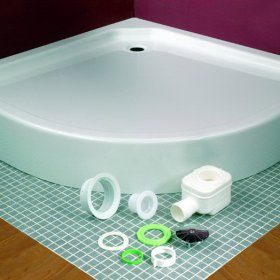
Buying plumbing equipment, we hope for a long and flawless operation of devices. At the same time, we often forget that a lot depends not so much on the model or cost of the structure as on the quality of its installation. A properly connected shower trap ensures reliable operation of the entire system.
Varieties of siphon designs - what to choose?
The drain siphon is a very important unit, which not only provides unhindered discharge of dirty water, but also blocks unpleasant odors from the sewer.
It is a curved pipe that holds back part of the water on the way from the cab tray to the sewer. The secret to the successful operation of the design is the presence of a so-called water lock formed in the upwardly bent pipe segment. Thanks to him, unpleasant sewer odors do not get into the apartment. With the help of a siphon, all plumbing devices are connected to the sewer, except for those in which a water lock is an integral part of the design.
When choosing a siphon for a shower tray, you should know that this seemingly simple device can be of several types, seriously differing from each other in design features:
- Tubular or knee siphons. They are a curved pipe segment, most often U or S-shaped. Due to its shape, they ensure the constant presence of water in the upper segment of the system, which works as a water seal. For ease of use, a hole may be located at the bottom of the structure to remove blockages without disassembling the entire structure. A corrugated siphon is considered a variety of this type, a distinctive feature of which is not only the shape of the pipe, but also the possibility of fixing in the desired configuration with a clamp. Thus, the structure is easy to place in the most convenient way for use and to organize high-quality drainage of water from the shower cabin, regardless of how the sewer pipes are located. Another advantage of the system is the only connecting node at the outlet of the sink, which minimizes the possibility of leaks. The disadvantages include sensitivity to high and low temperatures and rapid contamination of folds.
- Bottle designs are rigid in shape and resemble a bottle in their appearance. The siphon cylinder is closed from the ends, a pipe is attached to its upper part, attached to the outlet from the sanitary equipment. Another pipe designed to drain water is located in the side. The drain hole is slightly higher than the bottom cut of the vertical pipe, so a water shutter forms in the cylinder.It’s quite simple to organize a device for draining the shower cabin using such a siphon: compared to the knee, it is easier to install, easier to disassemble and clean.
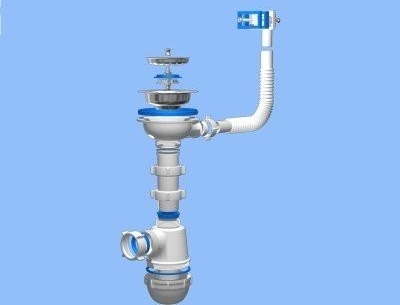
It looks like a bottle siphon. It is much more often installed than cranked, because it is more convenient to use.
Different types of devices can be used in different models of cabs. Much depends on the depth of the pallet and the preferences of the owner. There is another system that is used for this purpose, the so-called drain drains for the shower. The device can be installed directly on the floor or in the pallet. The height of the stairs is from 8 to 20 cm, but it is believed that the smaller it is, the better.
The construction is extremely simple and designed for unimpeded drainage of water from the pan.
Features of installation
Installation of the drain is carried out during the installation of the shower after the base is prepared for the installation of the tray. There are several stages of the installation process:
- Correctly set the drain angle of the pallet to the sewer tee. To do this, first turn the pallet upside down, screw the studs that come with the cab into the right places. We prepare power elements by screwing restrictive elements onto them. We put the power elements on the studs mounted on the pallet. We fix the siphon together with a flexible hose. Using the level, we adjust the power frame so that it is 2-3 cm above the lower point of the siphon. Using nuts, we finally fix the power structure. Turn the pallet over, set it in place and adjust the height of the legs. As a result, the lower point of the drain hole should be 5 degrees higher than the sewer tee.
- We connect a drain for a shower cabin. To do this, insert the mesh into the drain hole. For better protection of the assembly, it can be pre-coated with sealant. After installing the gasket, we use a screw to connect the tee. Then we connect the siphon with a tap and a square, while not forgetting that the joints are sealed with gaskets. We insert a tap into the hole of the sewer pipe and seal the area with a special sleeve and sealant. We finally connect the tee and siphon.
Often, deep pallets are equipped with a special plumbing fixture, which is called a drain overflow for a shower cabin. It is used to prevent transfusion of water over the edge of the pan. Drain in such a system is set as described above.
Overflow installation begins with securing the outlet with a screw and mesh in the overflow hole of the pan. Then it is inserted into the pipe, like this:
The speed of water flow, and, by and large, the ability to use plumbing equipment depends on a competent installation of a shower cabin drain. Responsible work can be successfully completed by yourself, you just need to follow the instructions and conduct all operations in a quality manner. The result of the effort will be a well-functioning comfortable shower.

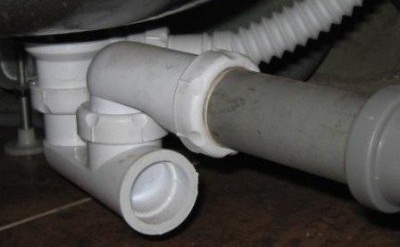
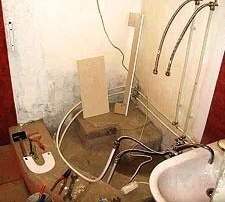

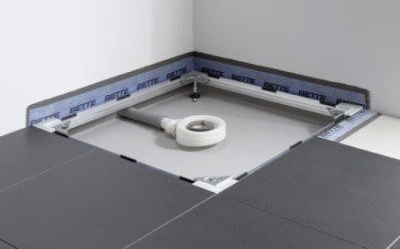
1 comment